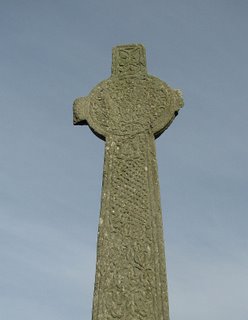




Our journey, made by twelve people from our church, really began in 563, when the Irish nobleman and monk Columcille (known by the Latin Columba) turned his back on his native land, ostensibly following a dispute now lost to legend (but possibly involving his plagiarism of a manuscript and initiation of a war over its return) and headed across the sea. Little is known about Iona's Iron Age pre-Columba past, but by the time Columba himself arrived, a Gaelic-speaking Irish aristocracy, the Dal Riata, was in charge of the place known as Dalriada, the western coast of Scotland. Columba and his followers founded a number of churches on the mainland and islands, with Iona becoming one of the most famous.
We were there in part due to the gleam lodged in our pastor's eye ever since the idea of a pilgrimmage to Iona had come to her, and in part as a culmination of our year-long adult-education program on the traditions of the church. The previous year we had focused on the Bible, and in the upcoming year we will look at spiritual practices, but last year we started with the early Jesus movement and made our way through the early creeds, the medieval church and its monasteries and mystics, the split between East and West, the Reformation, and the modern church in America. (No, for all of you emergent church fans -- we never did get that far.) Iona, with its Celtic Christian to Roman Catholic to Protestant history, was an ideal objective for our year-end journey.
It's hard for us to imagine -- we flew to Glasgow and the next day took a three-hour train ride to the coast, an hour's ferry to the island of Mull, an hour's bus ride across Mull, and then a short ferry to Iona -- but in Columba's day, overland travel was so dangerous that the sea was considered a fast and efficient venue and Iona easily accessible. When you stand on Columba's beach, you have to wonder.
The images (these are worth clicking on to enlarge):
(1)MacLean's Cross, c. 1500
(2) Contemporary pilgrims en route to Columba's Bay, where the saint reportedly landed in his coracle.
(3) The hillside Columba climbed upon his arrival; he wanted to ensure that he could not see Ireland from any point on Iona before he made up his mind to stay!
(4) and (5) Columba's Bay, a number of whose stones now line one of my bedroom bookshelves.
















9 comments:
Your photos are so amazing!!
Great photos. Iona even looks mystic.
Wonderful as always. Ellyn
Beautiful. Ancient Colmekill, legendary Avalion.
Did you know that my sailboat was named "Coracle"?
Gorgeous photos of a place I'm sure I'll only ever see through the lens of your camera so thank you for sharing them. I particular liked the stones and can understand having them in your bedroom!
The colors on the stones on the beach are just amazing!
Meg
Brings back some good memories. My wife and I were there two summers ago and stayed for a week at the Abbey. Loved it.
I'm curious about the term Celtic Christianity because I was under the impression that Christianity was brought to the Celts by the Romans i.e. Roman Catholicism replaced non-Christian Celtic religions.
One of the churches I attend when travelling to Connecticut is St. Columba. I knew nothing about the name before doing so much reading about the Celts this summer.
Kathryn:
http://www.wilfrid.com/Wilfrid_pilgrimage/Whitby_synod.htm
Post a Comment